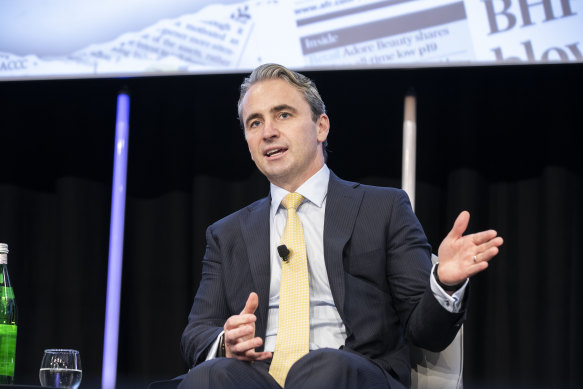
CBA profits jump 9 per cent to $5.15b on rate rises
Rising interest rates have helped the Commonwealth Bank’s first-half profits swell to $5.15 billion, as the lending giant said it remained optimistic Australia’s economy would have a soft landing.
CBA chief executive Matt Comyn said the bank expected slower economic growth this year, but the fundamentals of the economy remained “solid”.Credit:Louie Douvis
CBA on Wednesday reported cash earnings of $5.15 billion for the December half, a 9 per cent increase, as it lifted dividends sharply and said it planned to increase its share buyback by $1 billion. CBA shareholders will receive an interim dividend of $2.10, a 35c increase from the same period last year. The profit result is in line with market expectations.
Chief executive Matt Comyn said the bank expected slower economic growth this year, but the fundamentals of the economy remained “solid,” pointing to low unemployment, strong exports, and increasing migration.
“We are conscious that many Australian households are feeling significant strain from rising interest rates, alongside the rising costs of electricity, groceries and other household items. Despite this, consumer spend remains resilient, with signs of spend slowing in pockets,” Comyn said.
“We expect business credit growth to moderate and global economic growth to slow during 2023. However, we remain optimistic that a soft landing for the Australian economy can be achieved and positive on the medium term outlook for Australia.”
CBA and other banks have reaped the benefits of rapid-fire interest rate rises by lifting their lending rates more quickly than deposit rates. This has caused sharply wider net interest margins, which compare bank funding costs and lending rates, and are a critical driver of profitability.
CBA’s net interest margin rose by 18 basis points compared with the six months to June, to 2.1 per cent, which it said was caused by rising interest rates.
Expenses for impaired loans increased by $586 million, though bad loans remained at low levels overall, despite the impact of rising interest rates and increasing costs of living for households.
Since May last year the Reserve Bank of Australia has lifted the cash rate from 0.1 per cent to 3.35 per cent, and markets are pricing in about three further rate hikes in response to the highest inflation in decades.
More to come
The Business Briefing newsletter delivers major stories, exclusive coverage and expert opinion. Sign up to get it every weekday morning.
Most Viewed in Business
From our partners
Source: Read Full Article
